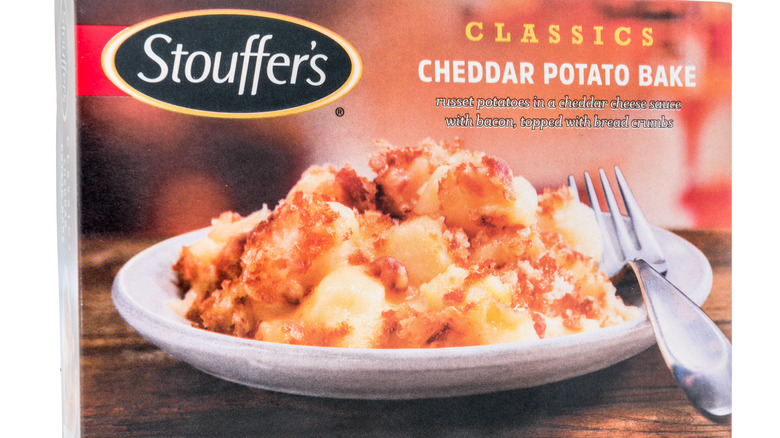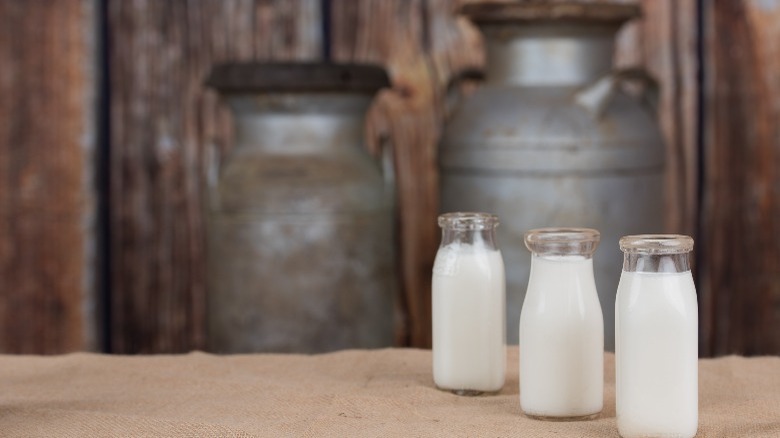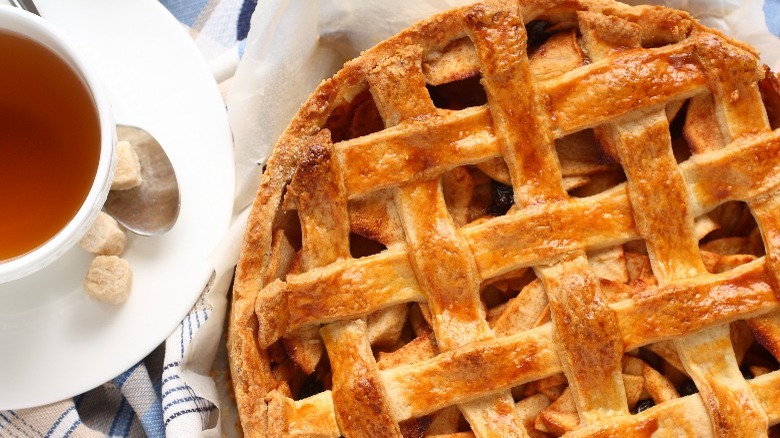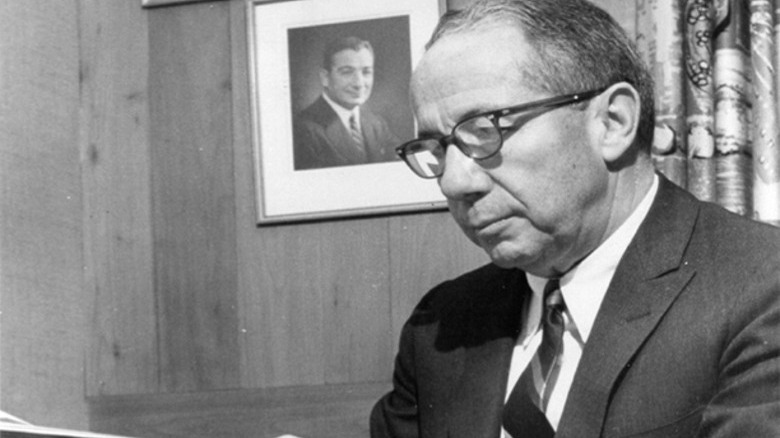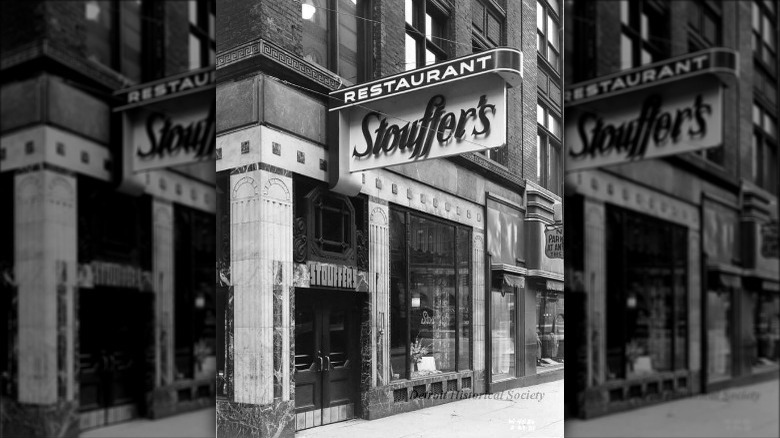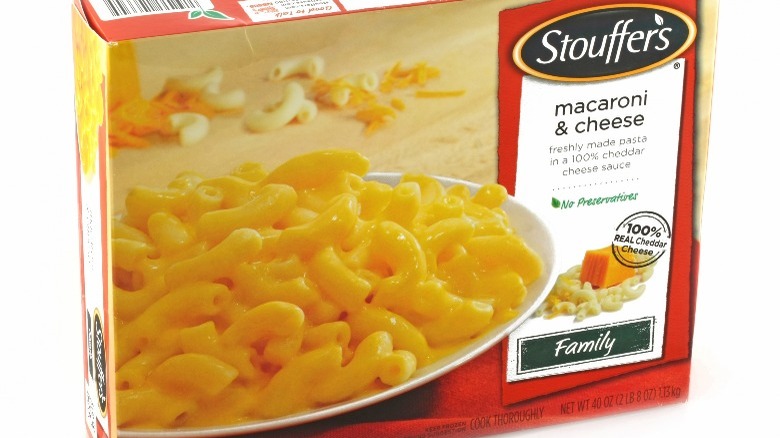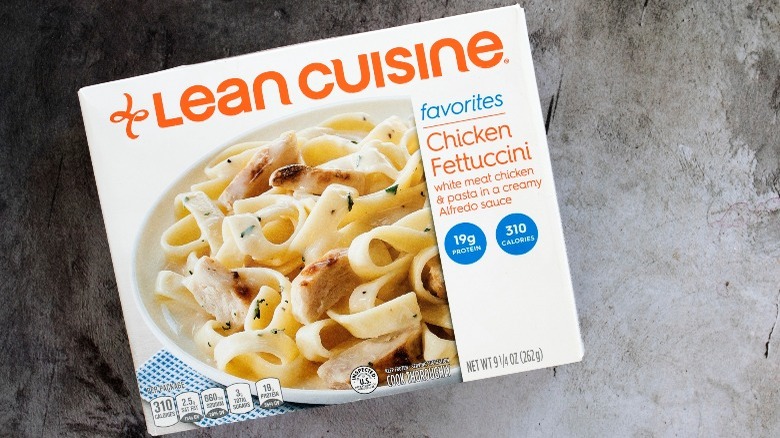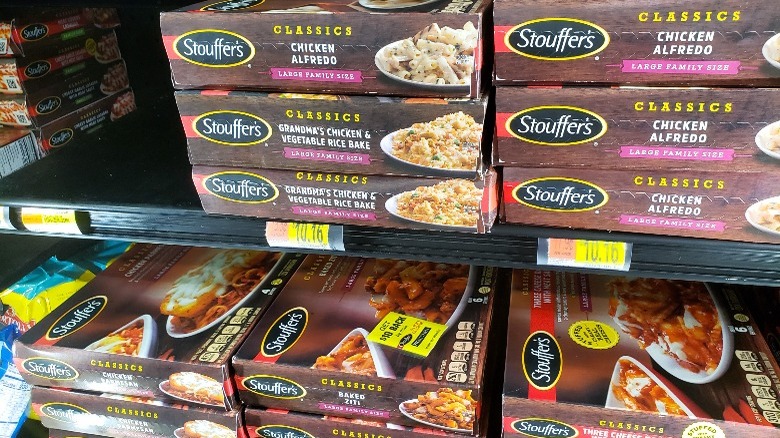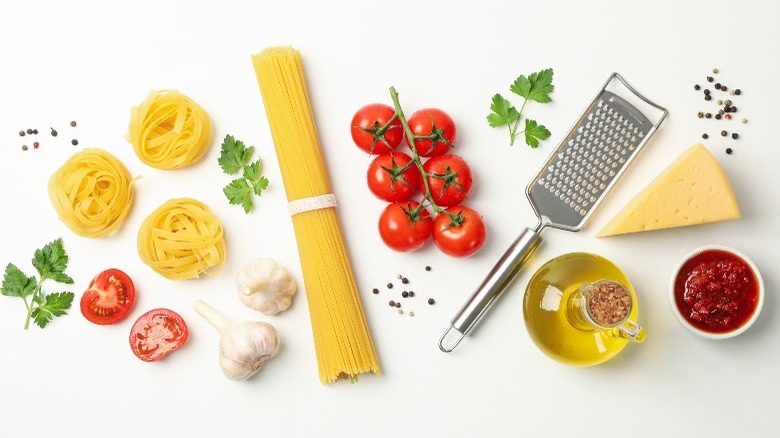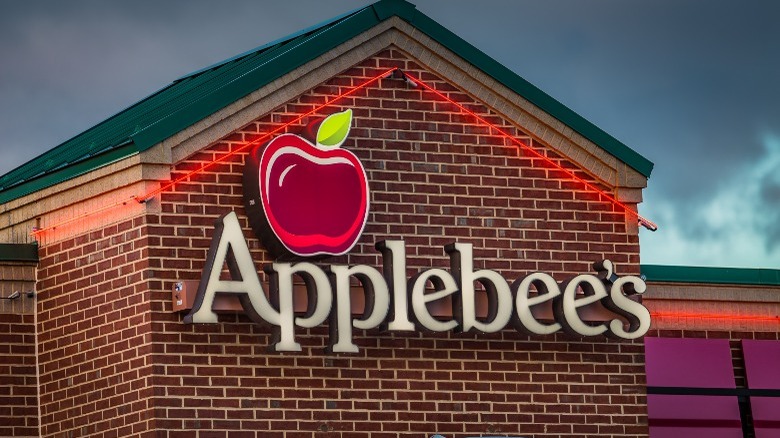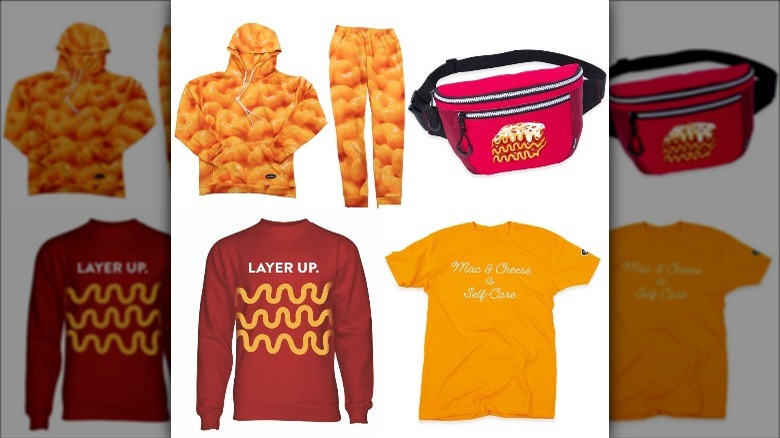The Untold Truth Of Stouffer's
We've all been there — perusing the frozen food aisle of the grocery store to find a quick dinner, to fend off a pizza craving, or to pick up some toaster waffles for a lazy breakfast. Whatever you're in search of, it's hard to miss the sea of Stouffer's entrees that monopolize much of the section. The instantly recognizable meals such as the classic lasagna and macaroni and cheese stare back at you through the frosty glass windows with mouth-watering photographs plastered on the cardboard box covers. But did you have any idea of the stories behind those products and the hard work that went into them over the past 100 years?
Stouffer's has been owned by Nestle USA, Inc. since the '70s, but its history stretches back almost a century (via GoodNes). Stouffer's wasn't always a frozen food titan; over the years the brand put its name on a series of restaurants and a chain of hotels. Yes, hotels — that might surprise you if you only know Stouffer's from frozen single-serve Salisbury steaks. There was also that one time it came up with the novelty idea to dispense its macaroni and cheese on tap. That was a little strange, so for now let's focus on how Stouffer's came to be and how its line of foods is still going strong today.
Stouffer's had humble beginnings as a creamery
Abraham Stouffer was born in 1875 and grew up on a farm in Columbiana County, Ohio. He moved with his family to the town of Medina, Ohio, where he and his father began the Medina County Creamery in the early 1900s. Together, they expanded their business and set up a dairy stand in Cleveland at the Sheriff Street Market. In 1922, Abraham opened a dairy stand in downtown Cleveland's Arcade Building. It would prove to be a defining moment in the entrepreneur's life (via Case Western Reserve University). Cleveland was a booming city at the time, which made it ripe for businesses to succeed. According to Cleveland.com, the population throughout the '20s was about 800,000 and the city was humming with economic activity.
At the new stand, the Stouffers served fresh buttermilk to their customers. Free crackers were provided too. But it didn't stop with that extremely limited menu — business only went up from there, especially after they added more menu items (via Cardboard America). The dairy stand would mark the beginning of the Stouffer's enterprise that has since grown into the food giant we know today.
The company's initial success was thanks to homemade apple pie
The sparse menu of fresh buttermilk and crackers proved to be enough to attract customers, and Abraham and Lena Stouffer transformed their little dairy stand into a quaint coffee shop/restaurant by adding sandwiches and fresh-brewed coffee (via Zippia). In the era of Prohibition, apparently it wasn't a challenge to attract city-goers for a tall glass of buttermilk and a sandwich, but these items weren't the showstopper. As the idiom goes, "you can't live on milk and bread alone."
The real draw at the first Stouffer's restaurant was Lena's homemade Dutch apple pies. Her pies are credited with the shop's initial success, according to Case Western Reserve University. As we'll explore later on, the apple pies remained on the Stouffer's menu when the family ventured further into ownership of their own restaurant chain. Unfortunately, Stouffer's doesn't offer the classic dessert in frozen form these days. It does sell Harvest Apples that you could technically use to make an apple pie, but it likely won't be as delectable as Lena's homemade kind.
Abraham and Lena's son, Vernon, grew the business
Abraham and Lena's son, Vernon Stouffer, joined his parents' business shortly after graduating from the acclaimed Wharton School at the University of Pennsylvania. He aimed to maintain the homestyle flavor and quality standards that were set by his parents since they had opened their creamery, but he also expanded the Stouffer's business dramatically (via Wharton Magazine).
Vernon helped his parents open their first full-sized restaurant, Stouffer Lunch, in 1924, only one year after his graduation. The family's business values were reflected in their new motto, "Everybody is somebody at Stouffer's", according to the University of Houston. He grew his parents' small business into a large chain of restaurants. Per Wharton Magazine, he is also credited with pioneering the idea of using a test kitchen to develop recipes for a restaurant chain. He would personally taste the food and give his stamp of approval before adding it to the menus at his chain of Stouffer's restaurants. Because of Vernon's innovation and commitment to this hands-on approach, he ensured the very best quality at his family's restaurants. Vernon remained chairman of Stouffer's until it was sold to Nestle in 1973. He was the major architect of a decades-long empire that would eventually move beyond restaurant foods.
Stouffer's restaurants were vital in shaping the company's legacy
After the Stouffer family opened the first restaurant in 1924, brothers Vernon and Gordon Stouffer broadened the company's reach by opening sit-down establishments in major cities of the era, such as Cleveland, Detroit, and Pittsburgh. According to Taste, the restaurants featured homemade food and a pleasant atmosphere with attentive service. The prices were fair and the food was delicious. It was a homey type of place that was perfect for a family or a young couple on a date. A luncheon menu from 1941, posted by the Culinary Institute of America, lists rib-sticking meals such as Swedish meatballs with whipped potatoes and gravy, roast beef sirloin on toast with homemade chili sauce, club sandwiches, vegetable plates, and desserts like lemon meringue pie and of course the famous apple pie
The "Top Of" restaurants were more upscale dining experiences located on top of skyscrapers in America's most important cities beginning in the late 1950s. The location in Chicago opened in 1956. It was called Top of The Rock, and was located in the shiny new Prudential Building. It provided breathtaking panoramic views of the city. However, it closed in 1976. There were 16 "Top Of" restaurants, with each having its own special theme and decor, such as a French theme in New York, a Southern garden in Atlanta, and Great Lakes ship decor in Milwaukee.
Customer demand sparked the production of frozen foods
At this point, you may be wondering how the frozen foods we associate with Stouffer's came into existence. While Vernon was the brains behind the success of the restaurants, the inspiration for the frozen entree packages that you see in the grocery store aisles came from Stouffer's customers. At the Stouffer's Shaker Square restaurant, devoted divers began asking for ways to take their meals homein order to prepare them later. Some of the customers would take the meals and freeze them on their own, which they recommended to the restaurant staff. Per Ohio History Central, these requests are what inspired the Stouffer family to begin producing pre-frozen meals for customers to purchase.
During the 1950s, the company faced some competition from Swanson and Sons' TV dinners that were widely available in supermarkets, but Stouffer's stood out because of the homemade quality of its foods. Demand was further increased when it became more common for women to work and they needed convenient meals that were easy to prepare at home and that didn't take up too much time. The considerable growth in sales caused Stouffers to open their own small manufacturing plant for mass production. (via Nestle). In 1956, they incorporated their frozen foods division into Stouffer Foods. By the time the '60s rolled around, the frozen entrees were being sold in supermarkets and the company opened another manufacturing plant in Solon, Ohio.
Stouffer's owned prestigious hotels and resorts
When Stouffer's decided to explore business opportunities outside of food, the company purchased the Anacapri Inn in Fort Lauderdale, Florida in 1960. Then it incorporated a new division called the Stouffer Hotel Company (via Eating The Road). Over the next two decades, the brand acquired nearly 20 motels across the Midwest but the motel business began to falter. When William Hulett became president of the hotel division, he set out on a complete refresh. Throughout the 1980s, he led the company to acquire numerous upscale, esteemed hotels in locations like Washington D.C., Hawaii, and the Caribbean.
According to Company-Histories, by 1990 the Stouffer Hotel Group establishments were known for five-star customer service, luxury amenities, and top notch dining. The following year, Stouffer's merged its hotel and restaurant divisions to create the Stouffer Hospitality Group. At that time, the company owned 68 restaurants and 40 hotels and resorts (via GoodNes). However, Nestle chose to consolidate business as a whole and sold all of the hotels and restaurants, which left only the frozen foods division. The hotels that were sold in 1992 went to New World Development, which owned the Renaissance and Ramada chains.
Stouffer's fed the astronauts after the moon landing
Astronaut food is commonly thought of as bland, dehydrated camping-type food, and that's partly the case, but not entirely. According to NASA, nutritional value is taken into high consideration due to the arduous journey and astronauts are normally able to choose which foods they want to take into space with them. But the food they consume after an extraterrestrial mission is just as important for their health and safety. During the Space Race, Stouffer's was chosen by NASA to provide frozen meals for astronauts after the Apollo 11 mission — the one that landed the first humans on the moon.
According to a press kit from Stouffer's, the Apollo astronauts' 21-day quarantine lasted from July through August 1969 to ensure no foreign and potentially dangerous organisms were brought to Earth from the moon. They needed something good to eat for those three weeks. Stouffer's foods were chosen for quality, but also for their convenience of use and preparation (the meals could be heated in an oven). Boneless short ribs, escalloped chicken and noodles, and lasagna were just some of the dozens of Stouffer's entrees chosen for the crew's return to Earth (via WGNO). The program launched an ad campaign for Stouffer's that used the slogan "Everyone who's been to the moon is eating Stouffer's."
Black women played a major role in the company in the 1960s
Stouffer's employed black women to help create and prepare the Apollo 11 quarantine food. According to Lady Science, these women made those meals happen, yet sadly their contributions fell under the radar of most publications at that time. The black press covered the labor of these trailblazing women and it's important to recognize their accomplishments today. Their names were Julie Stewart and Sara Thompson.
Stewart worked as an aide to Doris Davis Centini, a Stouffer's home economist who played a leading role in developing the quarantine food program. Stewart's recipe for Salisbury Stroganoff was even a selection for NASA's astronaut menu. Thompson was a quality control supervisor who used scientific testing to make sure all the food served to the astronauts met the purity standards set by NASA, Stouffer's, and the FDA (Food and Drug Administration) (via James Beard Foundation). These women were key in creating and ensuring the quality of Stouffer's foods for the NASA astronauts during the most remarkable space event in history.
The company led the diet frozen food craze in the 80s
The 1980's were a decade full of health food fads, from aerobic workouts in neon spandex and downing weight loss pills, according to Eat This, Not That. In 1981, Stouffer's took advantage of the decade's health obsession and launched a new line of food, Lean Cuisine. Consumers were eager for diet food products that didn't sacrifice portion size, taste, and convenience, and Lean Cuisine answered their needs.
Stouffer's spent a decade on the research and development of its frozen diet entrees and focused on adding more vegetables and herbs for flavor. The brand claims to work closely with nutritionists to ensure high quality and solid nutrition (via GoodNes). The meals in the original line contained a maximum of 300 calories and were available in ten varieties. The brand was instantly a huge hit, quickly outselling its competitor, Weight Watchers. Lean Cuisine later faced harsh competition from the Healthy Choice line by Conagra Brands. By the 1990s, the frozen entree market was shrinking, but Stouffer's continued to expand Lean Cuisine and took back the top spot in the diet frozen food space with the help of Lean Cuisine's brand new macaroni and cheese (via Company-Histories).
Stouffer's frozen foods are still going strong today
If you've been in pretty much any grocery store aisle, you know that Stouffer's frozen foods continue to succeed today, several decades after they were first released. According to Statista, as of February 2021, Stouffer's was ranked as the number one brand of single-serve frozen dinners in the US, beating out Marie Callender and Healthy Choice. The brand was also listed as the number one multi-serve (family-sized) brand of frozen food (via Statista). Food Dive reported that sales of frozen foods skyrocketed in 2020 and that Nestle chose to invest in a $100 million expansion at the Stouffer's factory in Gaffney, South Carolina.
While the lineup has changed throughout the years, Stouffer's still currently offers classic fan favorites like Salisbury steak, French bread pizza, and lasagna. The lasagna comes in a variety of flavors these days, including Cheesy Garlic, Meat Lovers, Meatless, Veggie, and others. Some of the brand's newer products are a bit different, such as the Bowl-Fulls and Mac-Fulls, which combine macaroni and cheese, a meat such as chicken, and a vegetable.
Stouffer's uses real ingredients
Stouffer's long-time commitment to quality food is evident today by the claims made on the Nestle Professional website. According to the company, Stouffer's uses real ingredients without any preservatives in its frozen entrees. The vegetables are sourced from California farms, while the cheeses, milk, and cream are selected from nationwide dairy suppliers. For example, the brand's famous macaroni and cheese is made with 100% sharp cheddar cheese, elbow macaroni, and sea salt (via Nestle).
In 2016 Stouffer's launched a wholesome marketing campaign that highlighted the company's ingredients. Stouffer's has always claimed to want its foods to match up with the quality of any homemade family meal, made with good ingredients and with great consideration for the customers' well-being. The ads made ample use of the tagline, "Made for you to love," showing that the brand wants consumers to be able to form an emotional connection with Stouffer's products (via PR Newswire).
Applebee's sued Stouffer's
In 2003, the American restaurant chain Applebee's sued the Switzerland-based Nestle company over the use of the product title Skillet Sensations on a line of Stouffer's frozen meals. According to the Wichita Business Journal, Applebee's claimed to have been the first to use the phrase back in November 1996 for the savory fajita-like meals offered in its restaurants. The dispute focused on the dates that each company had applied for trademark rights to the phrasing. The courts ultimately ruled in favor of Applebee's and determined that consumers may be confused as to the relation between the two products due to the wrongful use of the name. Stouffer's was then ordered to stop using the title.
Stouffer's had allegedly started using the product title to use with similar food products — sauteed skillet meals made with meats and veggies — only about one year after Applebee's had introduced its own Skillet Sensations. Applebee's Skillet Sensations were available in the company's restaurants and for dining and takeout, while Stouffer's versions were only available in the frozen foods aisle of grocery stores (via Progressive Grocer).
Stouffer's has a line of merchandise
It's a more common sight nowadays to see food brands plastering their name and products all over merchandise, from Pizza Hut's red tracksuits and slides to P.F. Chang's t-shirts and cookware. It seems like everywhere you turn there's another brand dishing out delicious merch. Stouffer's jumped in on the action in November 2020 when it debuted a line of merchandise. The goods were made available just in time for the holidays.
The decision to release the merch came from overall consumer demand and simply the right timing. The marketing team and Stouffer's wanted to provide comfort for their customers during what had been a rough year for everyone (via PR Newswire). The collection of unique items is themed around Stouffer's fan-favorite food products such as lasagna and mac and cheese. The products include a range of quirky and practical things, from a macaroni-print fleece blanket, lasagna t-shirt, lasagna-print pet collars, puzzles, and even a full-patterned mac & cheese sweatsuit. So if you'd like to be covered in mac and cheese without all of the mess, then Stouffer's might have exactly what you're looking for.
Stouffer's aims to stay relevant with a new generation of consumers
In recent years, Stouffer's has been working hard to prove that it's not just your grandmother's comfort food. The brand currently has over 53,000 followers on its official Twitter page, which has been active since 2009. Stouffer's has also been teaming up with bloggers to target its younger, more tech-based audience. In 2016, Stouffer's began to use influencers to share the authentic story of the company and to promote the brand in a fresh and relevant light. According to Food Navigator-USA, Stouffer's used hashtags, beautifully-plated food, and food photography workshops to win over a crowd of food bloggers.
That same year, the company eliminated artificial ingredients from over 140 of its products in an effort to appeal to a consumer market that is increasingly concerned about what's in their food. Per Food Business News, Nestle has been proactive across its various brands (DiGornio pizza and Toll House cookies, for example) to eliminate artificial ingredients while keeping the same appetizing tastes that its customers have come to love. Stouffer's changes also included introducing new varieties of gluten-free, high-protein, and organic meals.
